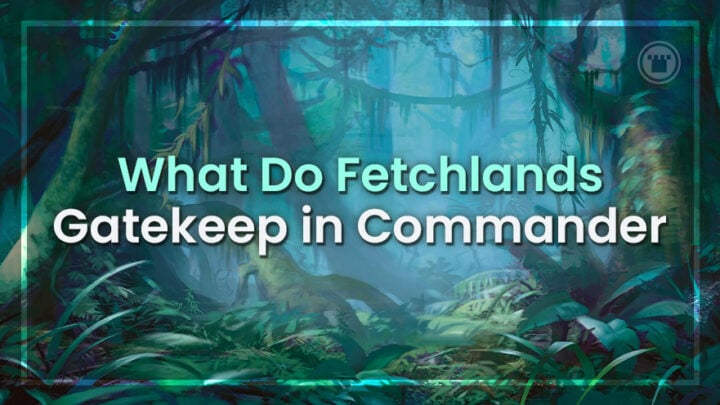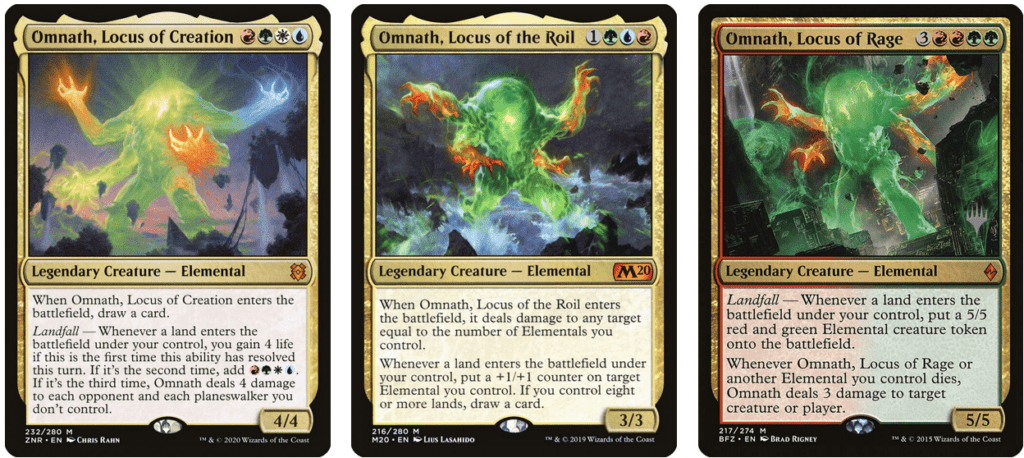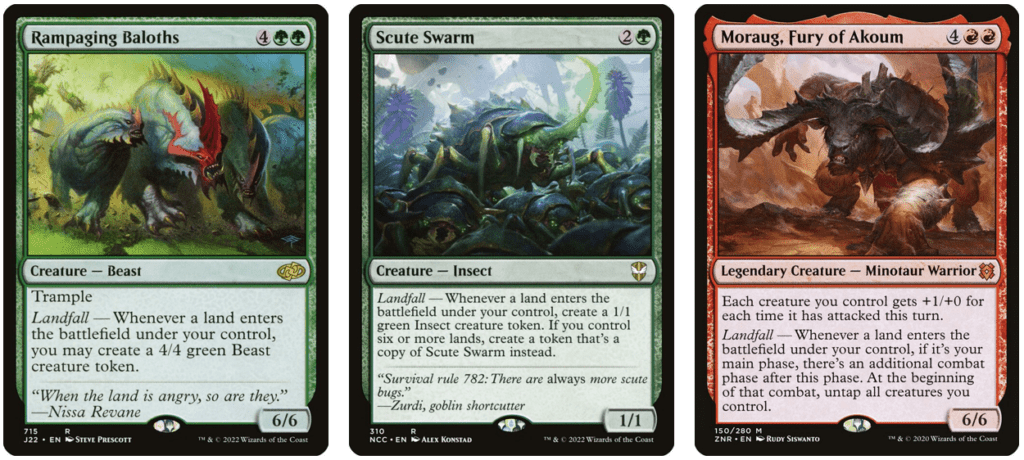Fetchlands are widely considered a staple in Commander. They help decks with mana fixing and consistency. What strategies are carried by Fetchlands, and what decks do they gatekeep?
Fetchlands are great in Commander. You can grab a Shockland or Triome off of them to hit your colors, you can use the triggers for various ends, and you can slightly improve your draws in the mid to late game by removing lands from your library.
They aren’t by any means necessary for most decks, though. Mono color decks obviously don’t need them for the most part, and two colors decks can also do just fine without them too. Even three color decks can survive without them if built with a good mana base, mana rocks, and treasure.
They do, however, end up being fairly essential to building optimally for certain strategies, and around certain cards.
So, what do Fetchlands gatekeep in Commander?
MULTICOLOR DECKS
First up, we have to acknowledge how useful they are in decks that are four or five color. No matter the Commander, running this many colors is very taxing on a mana base (as it should be). Unless you’re doing mono-black Ezio Auditore da Firenze, you’ll benefit greatly from running some fetchlands to fix your colors.
There are also many multicolor Commanders in three colors that want you to be running fetchlands for maximum efficiency. Muldrotha, the Gravetide is one, given you can play a land out of the yard on each of your turns. Another is Korvold, Fae-Cursed King, who draws cards when you sacrifice a permanent. Both decks can be built on a budget and work reasonably well, but the threat-level of the Commanders is so high that by building in a suboptimal way, you’re really just giving up your edge at the tables these decks are suitable for.
LANDFALL DECKS
The main type of deck that doesn’t hit anywhere near the heights it can without Fetchlands is the Landfall deck.
There are many flavors of landfall, but the big angry jelly bean is the most iconic, especially given the evolution and addition of more colors through the years. Omnath loves you playing more lands per turn in order to hit those sweet sweet triggers, with Locus of Creation especially wanting you to hit three drops a turn. Now, obviously, you can do this with ramp or effects that let you play additional lands… but most often, it’s easier to have one of those two effects + a fetchland, rather than both.
Landfall decks that give you extra card draw when you play lands are obviously among the better ways to play landfall strategies, and, indeed, the better ways to use fetchlands. With two fetchlands (say, a Misty Rainforest and a Fabled Passage), you can draw four cards in a single turn with Aesi, Tyrant of Gyre Strait. And you could even draw more if you also played a ramp spell that turn too!
The other value payoff for landfall is of course making even more mana. Tireless Provisioner is popular for a reason, and getting to make two treasures off of fetchland is bonkers value – some would say even better value than the two floating mana from a Lotus Cobra, which is still great.
Landfall also has numerous payoffs that help to win a game. Rampaging Baloths is a classic, but the newer Scute Swarm is arguably more terrifying because it grows exponentially. Moraug, Fury of Akoum is sweet in red decks, and even mono-red decks will want to run fetches like Bloodstained Mire or Scalding Tarn just to increase the chances of multiple combats.
LANDS DECKS
There’s a slight difference between landfall and lands decks; the latter tends to run more utility lands and play a more controlling approach, when compared to a landfall deck’s value snowball.
Decks like Thalia and The Gitrog Monster and The Gitrog Monster are sort-of landfall decks that are closer to lands decks. Fetchlands are great in these decks, both for mana fixing, and for filling up the graveyard.
Even the newest frog, The Gitrog, Ravenous Ride benefits from fetchlands. By building around this Commander, you’re going to want payoffs for dropping multiple lands in each turn. Naturally, fetches give you some extra value when you’re not popping off with the Commander.
There are some cards that arguably aren’t worth playing without fetchlands, like Life from the Loam and Field of the Dead. They’re supremely powerful effects, and without fetchlands, are somewhat neutered, especially when splashed in self mill or ramp decks that don’t otherwise have a unifying landfall through-theme.
The same goes for self mill decks that run effects like World Shaper or Aftermath Analyst; getting lands into the yard is just easier when you have fetchlands.
TOPDECK MANIPULATION
Topdeck manipulation means anything from Brainstorm to Sensei’s Divining Top. These ways to play and draw cards can be very powerful, but eventually, you’ll hit a chunk of lands, and run out of steam. Sensei’s Divining Top’s ability to look at your top cards is worth a lot more when you can shuffle your library, which is easy to accomplish many times a game by running fetchlands.
Scroll Rack, I would say, is even more dependent on fetchlands. If your current hand is a bit dead, and you exchange it with the top of your library, and it also ends up a bit flat, then you’re kinda stuck for the foreseeable future. Throw in a fetchland, and you get to completely get rid of that old hand, and have a chance at something brand new the next turn.
Mirri’s Guile and Sylvan Library are other versions of this effect that see a lot of play, and they are likewise significantly worse without a cheeky shuffle now and then.
Bolas’s Citadel is arguably the most powerful of the top-deck effects, and is a win condition in many decks. That win can feel many miles away without a way to shuffle the top of the library to get rid of annoying lands, though, so fetchlands feel necessary if you build around winning with it. It’s similar with Case of the Locked Hothouse, though a little less pronounced given you can play up to two lands off of the top before you brick.
SACRIFICE STRATEGIES
I already mentioned Korvold above, but there are many other decks that care about sacrificing permanents. Carmen, Cruel Skymarcher is one, and she especially thrives on you sacrificing fetchlands to get her going, and to give her some early game recursion and ramp.
WHITE “RAMP”
I wrote this year about the Boros Advantage Engine (or BAE). This engine is a key part of building a Boros deck that ramps hard, and it’s somewhat essential to have some fetchlands to make this engine work.
Key cards like Sun Titan, Sevinne’s Reclamation, Brought Back and Redemption Choir make fetchlands a source of ramp for mono-white and Boros decks.
END STEP
Fetchlands aren’t by any means necessary for decks to function, but some strategies and archetypes really depend on them to work optimally. Are those cards and decks “gatekept” by access to fetches? Not entirely, but for the most part, they kinda are.
Thankfully, fetches are at their cheapest for a long time due to multiple reprints, including Allied fetches in Modern Horizons 3. Hopefully this gives more opportunity to more players to play with fetchland adjacent cards in Commander.

Kristen is Card Kingdom’s Head Writer and a member of the Commander Format Panel. Formerly a competitive Pokémon TCG grinder, she has been playing Magic since Shadows Over Innistrad, which in her opinion, was a great set to start with. When she’s not taking names with Equipment and Aggro strategies in Commander, she loves to play any form of Limited.












